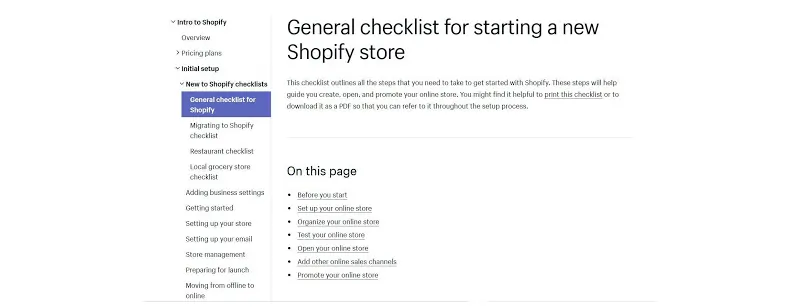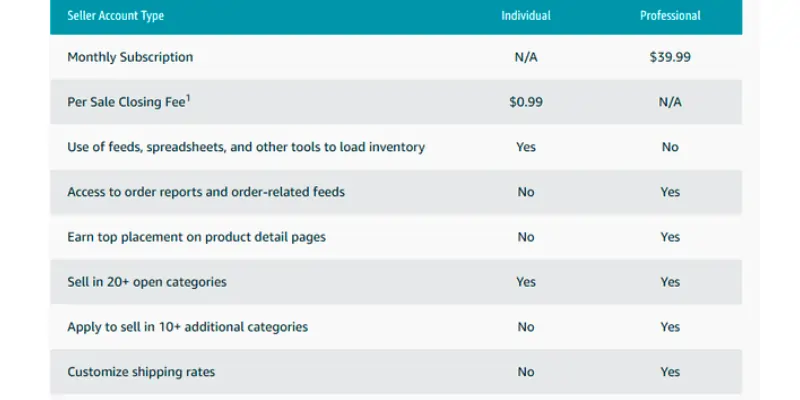
The pandemic has caused significant changes in how we shop and how customers and sellers connect. As a result, many sellers are going online to expand and reach new customers in order to stay relevant.
One of the most important decisions you'll make while selling online is which eCommerce platform will work best for you. You're probably going to compare Amazon vs Shopify when making this selection because they're two of the most well-known e-commerce platforms.
Today, the e-commerce market is dominated by two titans: Amazon and Shopify. They are both distinct and absolute giants of the eCommerce world. They provide sellers with a variety of options when it comes to selling online. But although both services let you put your products in front of a huge audience, they are very different platforms.
While Shopify is a tool that allows you to create your own digital store, Amazon is a huge online store.
When you sell on Shopify, it is like renting a space in which you set up your own shop. And, working with Amazon means selling your goods in a massive supermarket.
The primary difference between Shopify and Amazon is that with Shopify, you’ll have to set up things in the way you want and find customers. Here, you get total control over things. With Amazon, a broad customer base is already there but so is the competition.
Every month, over 2.5 billion people visit Amazon, while Shopify's platform supports over 1 million businesses. With stats like these, deciding on the best platform to sell on might be difficult.
Let's take a look at the primary difference between Shopify and Amazon and how these two e-commerce platforms can help you?

Looking to Create an Innovative E-commerce Website?
Amazon.com is an e-commerce behemoth, as you undoubtedly already know. But did you know that third-party vendors account for more than half of all Amazon sales? You can sell as a person or as a business on Amazon, and the marketplace offers a variety of shipping alternatives.
What are the key advantages offered by Amazon?
The most obvious advantage of selling your products on Amazon is that it makes it simple for customers to find you. According to eMarketer, 54 percent of users started their product searches on Amazon in 2018, whereas only 46 percent of search traffic originated on Google. As a result, if you're not selling on Amazon, more than half of your potential buyers may never find you.
These are some of the benefits offered to you by Amazon Marketplace as a seller:
Apart from these, there are some more perks of using Amazon, that we will discuss later in the article when we will compare Amazon Shopify.
Are there any disadvantages of using Amazon?
Well, every platform has some drawbacks. However, it might or might not impact your business as they are subjective. And it is wise to know about these so that you can stay safe by minimizing the extent of damage these might have on your business. Let us look at these:
Let us talk about Shopify marketplace and the benefits or disadvantages it has to offer. This will help us have a better understanding about Shopify Amazon before we jump to talk about differences between Shopify and Amazon:
Shopify is an e-commerce platform that allows you to set up an online store and manage all of your e-commerce services in one location, including inventory, payment processing, and shipping. It's also a hosted platform, meaning it's situated on the cloud. You don't have to buy software and pay to upgrade it because your Shopify membership gives you access to the most recent updates.
Let us look at the benefits offered by Shopify:
Are there any disadvantages of using Shopify?
Shopify too has some drawbacks, which you need to consider while you choose this platform as it can help you keep safe from any damages.
In order to understand Amazon Vs Shopify better, we have listed the differences based on certain factors to have a look at these.
Shopify is a much easier tool to utilize when it comes to creating an account. The beginner seller only needs to complete a series of forms that ask for information about the brand and the owner, and then they can start designing.

Setting up a Shopify account is simple, and merchants with no coding experience can create websites from the ground up.
You're not ready to commit just yet? To gain a sense of the platform, you can play around with it. They provide an option that says, “I’m just playing around.”
On the other hand, Amazon does not provide this choice. Before you can register, you must first prepare the following:
So, when it comes to starting a business, Shopify easily outperforms Amazon. In most cases, the former is just easier and faster to set up.
Pricing is a key factor in choosing between Shopify vs Amazon.
About Shopify Pricing
So how much does a Shopify website cost?
For the first 14 days, Shopify is free to use, and you don't even need to give your credit card information. After the trial period, you will have to choose one of the five alternatives accessible to you.
Shopify Lite is designed for people who don't want to build a Shopify web store but still want to use the cart functionality. When you sell on your own blog or other websites, you may use this to add a working buy button and a payment processing system. This is a good method to sell on your existing sites without having to establish a new one on another e-commerce platform, and it's only $9 per month.
Basic Shopify, on the other hand, allows you to manage your online store using Shopify. Because Shopify also offers free and paid templates that you may personalize for your business, you can design your entire website any way you want. You can choose the Shopify Plan if you're ready to take your business to the next level. This name is a little misleading because it's the platform's name, yet it's their mid-tier plan, which includes additional staff accounts and access to professional reports.
The Advanced Shopify Plan, on the other hand, includes additional features and charges a lower transaction fee percentage. Shopify Plus is ideal for high-volume retailers if you really want to go big. The pricing is not fixed and will be determined by your requirements. This proposal can be negotiated with their representatives.
In order to understand more about Shopify Vs Amazon, we can now read more
About Amazon Pricing:
Individual and Professional are the two options available to Amazon sellers. If you don't sell more than 40 pieces per month, the Individual Plan is for you. There are no monthly costs, but you must pay $0.99 plus a variable referral fee for each item you sell. Referral fees typically vary from 10% to 15% of the total sale price (with 15 percent being the overwhelmingly most common fee). You must also pay any shipping or Fulfillment by Amazon fees. Amazon gives two options to sellers: Individual and Professional.

Amazon offers two sorts of programs, with the seller's sales volume determining which one is selected.
On the other hand, the Professional Plan will set you back $39.99 every month. In addition, you will not be charged a $0.99 closure fee as with an individual selling plan, but you will be charged the variable closing fee as well as shipping/Fulfillment by Amazon expenses.
In 2019, around 218 million consumers made a purchase from a Shopify store. Around 2 million full-time jobs have been created as a result of the platform around the world. Shopify, on the other hand, will not advertise your store at all in order to increase visitors. It's entirely up to you to spread the word, whether through paid ads on Facebook and Google, SEO, or word-of-mouth.
However, when you list a product on Amazon, you will immediately receive a flood of free visitors. However, in addition to the free traffic, most Amazon merchants invest a significant amount of money in paid advertising. It has over 12 million products and $280.5 billion in total sales as a platform in 2019.
This is why, if you want to increase your consumer base quickly, Amazon is the preferable option. From toys to off-roading gear, the platform is the go-to marketplace for practically everything. While you won't be able to customize strings as much, if you handle your Amazon product launch correctly, even if you're a first-time seller, you'll have a greater chance of acquiring more customers. All of this, however, should be accompanied by a large asterisk. Although more individuals use Amazon for their shopping requirements, the site is also more crowded, and competition is fierce.
Picking a winner for this category is a no-brainer. With Shopify's free and paid themes, you can express your brand however you wish. They also provide a number of extensions that you may add to your website to improve your clients' experience. Amazon also allows sellers to create a storefront for their businesses, similar to eBay stores, however, they aren't, as customizable as Shopify sites.

Sellers can find a variety of extensions for their brand's website in Shopify's app store.
Amazon, on the other hand, restricts what vendors can change on their websites. This is why it's critical to optimize your listing. To stand a chance in this highly competitive industry, you must choose the greatest images and phrases to describe your goods.
To be fair to Amazon, the Enhanced Brand Content (EBC), also known as A+ Content Manager, is available. Sellers can use this free option to set themselves apart from other companies and show brand value. Essentially, it allows brands to better express their narrative to their customers.
Here is an example of A+ content:

Amazon EBC enables vendors to provide additional information about their products to their buyers. However, not all Amazon EBC merchants are eligible. You must be a registered trademark holder and have an Amazon Brand Registry account.
When your sales increase, you should concentrate on more than merely sending products. This will necessitate the assistance of third-party logistics. If you sell your product on Amazon, Amazon FBA (Fulfillment by Amazon) will handle this for you.
Uncle Max has various warehouses across the world where sellers' stocks are stored, as well as thousands of personnel who will ship your products to clients who place orders on the platform.

Amazon FBA allows third-party merchants to keep their inventory in Amazon's warehouses and have Amazon's employees package and ship orders to customers. This is extremely handy for third-party sellers because all they have to do is send their products from the factory to the warehouses and do business from the comfort of their own homes, in front of their computers.
This is, of course, not a free service. To get this convenience, sellers must pay FBA fees and FBA storage fees. The Shopify Fulfillment Network, on the other hand, was recently launched by Shopify. Although it isn't as simple as Amazon FBA, it is the platform's first attempt to compete with Amazon's fulfillment services. However, Amazon has a program that permits non-Amazon vendors to access their fulfillment centers and services. Amazon Multi-Channel Fulfillment is what it's called. You can utilize this service instead of the Shopify Fulfillment Network if you run a Shopify store.
It is important to make sure that applications such as Doubly are integrated with your marketplace platforms, such that it can do currency conversions as well. Having extra payment choices allows clients to purchase your products more conveniently, which can increase conversion rates.
Shopify Payments is a service that waives transaction fees. You can, however, employ third-party sources. You can choose from over 100 credit card payment providers, as well as direct and external sources, on the site.
Amazon also accepts a number of different payment methods. You can even shop with points, and the currency converter option comes in handy when selling to buyers all around the world.

Buyers may easily shop in their own currency on Amazon, thus currency conversion is not a concern.
The final consideration is how much control business owners have over their online operations.
If you've ever heard of Amazon seller accounts being suspended for no apparent reason, you're familiar with the horrors that brand owners face in Uncle Jeff’s lair. Every Amazon seller understands the strain of adhering to the platform's regulations, which is why, if you haven't already, you should read up on Amazon's new messaging policies.
Shopify, on the other hand, gives sellers complete control over their business. You're not renting a spot on a marketplace when you sell on Shopify. You own your site, and Shopify only provides a feature that streamlines the process.
Well, this comparison must have helped you better understand the differences between Shopify vs Amazon.
Let us now talk about something interesting about Shopify Amazon.
Shopify provides excellent customer support. You can ask for help from Shopify experts and other users on its forum anytime. Besides, you can also find the answers for your solutions in Shopify documents and video tutorials. The Shopify Changelog is another option to get the latest updates. You can access live support via email, live chat, and phone on Shopify Help Center 24/7.
Amazon is also known for its 24/7 support. The platform has a forum where users can post their queries and ask for support from other users. Its Help Center already has many frequently asked questions and answers. To get support directly from an Amazon customer support agent, you can connect them via email, live chat, and phone.
Well, Shopify and Amazon both are straightforward and easy to use. For Shopify, you don’t need to have any coding skills, you easily set up your Shopify store with its drag-and-drop design.
First register on Shopify and create an account. Then, you can make changes in the layout, colors, text, and so on by dropping media elements anywhere on the page. It also has an intuitive interface with visual cues, so you never face any issues when building your store. The back-end dashboard of Shopify is very easy to navigate.
At Amazon, you just need to follow certain steps to register a store. After that, upload your products information like the product category, SKU, product identifier, offer details (price, shipping option, etc.), product details (name, brand, etc.), and search terms, and then you are all set to sell.
Marketing is a must to reach your potential customers whether you are selling online or offline. Shopify comes up with a wide range of marketing tools. For SEO, Shopify provides certain SEO features for users to let you optimize the store-level content to ensure higher SERP positions. You can even make changes in the meta tags, add alt text to images, create 301 redirects and auto XML sitemap, etc.
However, you cannot customize your whole URLs. Moreover, Shopify brings numerous features for blogs like multiple authors, easy-to-set tags, and easy to customized SEO parameters. Moreover, you can do email marketing easily with Shopify Email.
For Amazon, you will need to focus on Amazon SEO to rank as high up the search result pages that you can. For this, first optimize your product information content and search terms.
Besides, Amazon also has many marketing tools such as Amazon DSP, which is a demand-side platform that allows you to buy display, video, and audio ads both on and off Amazon. Amazon Live allows you to stream live videos that are interactive, shoppable across Amazon.
Well, this comparison must have helped you better understand the differences between Shopify vs Amazon.
Let us now talk about something interesting about Shopify Amazon.
Most of you have this query in your mind, about Amazon Shopify. Here we have tried to address it.
There's no reason why you shouldn't broaden your horizons. Putting all your eggs in one basket is never a wise idea.
You can combine Amazon with Shopify to make things even easier. Connect your Amazon selling account and you'll be able to access Amazon customers right away. You'll get the best of both worlds this way.
With Shopify and Amazon integration, you can import existing products from Shopify and list them on Amazon in bulk, turn on inventory sync to keep it consistent and fulfill orders in one central place.
Shopify and Amazon Integration with LitCommerce
Here is the 4-step-process, follow them to reach tons of million potential buyers globally:
Step 1: Fill in the store ULR and the API password to connect Shopify to Amazon
Step 2: List products on Amazon with a single click.
Step 3: Sync Shopify and Amazon inventory.
Step 4: Manage Amazon orders from the central dashboard at LitCommerce.
The million-dollar question is this. Both solutions have significant advantages and disadvantages, as well as pros and downsides. The significant clout you'll gain from Amazon's current audience is a huge draw, and FBA allows you to focus on truly marketing your brand and items. It's also quite easy to set up.
However, fees can soon pile up, and selling specific things may be restricted. You must also be willing to follow Amazon's often stringent standards, which can be suffocating – especially if you want to expand your business.
Remember that you will never have complete control over your business because of buyer feedback and reviews, as well as pricing swings and competition from other sellers. Shopify allows you full control over your online store, including its design, style, and branding.
Everything in your store is under your complete control. The fees are also extremely reasonable. However, in order to reap the benefits, you'll need to put in a lot of time and effort.
You'll have to handle not only your business, but also your storage and fulfillment, customer support, marketing (which should not be overlooked), and spending time researching your competition to keep on top of things.
One of the most important decisions first-time eCommerce retailers must make is choosing between Shopify vs Amazon. Shopify is the obvious choice if you value brand presence above all else. However, if you want to increase the number of visitors to your site quickly, you should start with Amazon.
Both platforms have advantages and disadvantages. The good news is that you won't be forced to pick between the two for the rest of your life. The prudent thing to do in the long run is to combine the two to increase revenue and brand exposure. So instead of Shopify vs Amazon, you can go for Amazon and Shopify.

Looking to Create Innovative Ecommerce Website?
Q. Is there any difference between Shopify and Amazon?
A. Shopify is a specialized eCommerce platform and Amazon is an online marketplace.
Q. Can we sell on Amazon without creating account on Shopify?
A. Yes, you can sign up to sell on either Amazon or Shopify, even if you do not have a registered business.
Q. Can Shopify and Amazon work together?
A. Yes, you can work on Shopify and Amazon together. You just need to add Amazon as a Sales Channel in your Shopify store and create Amazon listings from existing products and complete orders directly within the Shopify admin panel.
Which platform do you believe is best for your company? Which side are you on Amazon or Shopify? Do write to us in the comments below what are your thoughts on Shopify vs Amazon?
In case, you are still confused about Shopify Amazon; feel free to connect with our experts. They will be glad to help you.
Leave a Reply